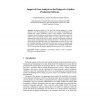Free Online Productivity Tools
i2Speak
i2Symbol
i2OCR
iTex2Img
iWeb2Print
iWeb2Shot
i2Type
iPdf2Split
iPdf2Merge
i2Bopomofo
i2Arabic
i2Style
i2Image
i2PDF
iLatex2Rtf
Sci2ools
HCI
2009
2009
Impact of Gaze Analysis on the Design of a Caption Production Software
Producing caption for the deaf and hearing impaired is a labor intensive task. We implemented a software tool, named SmartCaption, for assisting the caption production process using automatic visual detection techniques aimed at reducing the production workload. This paper presents the results of an eye-tracking analysis made on facial regions of interest to understand the nature of the task, not only to measure of the quantity of data but also to assess its importance to the end-user; the viewer. We also report on two interaction design approaches that were implemented and tested to cope with the inevitable outcomes of automatic detection such as false recognitions and false alarms. These approaches were compared with a Keystoke-Level Model (KLM) showing that the adopted approach allowed a gain of 43% in efficiency.
Automatic Visual Detection | Caption Production Process | HCI 2009 | Human Computer Interaction | Labor Intensive Task |
| Added | 18 Feb 2011 |
| Updated | 18 Feb 2011 |
| Type | Journal |
| Year | 2009 |
| Where | HCI |
| Authors | Claude Chapdelaine, Samuel Foucher, Langis Gagnon |
Comments (0)

